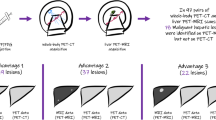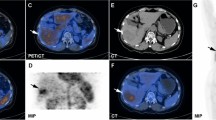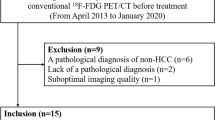Abstract
Purpose
The aim of the present study was to evaluate the added diagnostic value of respiratory-gated 4D18F–FDG PET/CT in liver lesion detection and characterization in a European multicenter retrospective study.
Methods
Fifty-six oncological patients (29 males and 27 females, mean age, 61.2 ± 11.2 years) from five European centers, submitted to standard 3D–PET/CT and liver 4D–PET/CT were retrospectively evaluated. Based on visual analysis, liver PET/CT findings were scored as positive, negative, or equivocal both in 3D and 4D PET/CT. The impact of 4D–PET/CT on the confidence in classifying liver lesions was assessed. PET/CT findings were compared to histology and clinical follow-up as standard reference and diagnostic accuracy was calculated for both techniques. At semi-quantitative analysis, SUVmax was calculated for each detected lesion in 3D and 4D–PET/CT.
Results
Overall, 72 liver lesions were considered for the analysis. Based on visual analysis in 3D–PET/CT, 32/72 (44.4%) lesions were considered positive, 21/72 (29.2%) negative, and 19/72 (26.4%) equivocal, while in 4D–PET/CT 48/72 (66.7%) lesions were defined positive, 23/72 (31.9%) negative, and 1/72 (1.4%) equivocal. 4D–PET/CT findings increased the confidence in lesion definition in 37/72 lesions (51.4%). Considering 3D equivocal lesions as positive, sensitivity, specificity, and accuracy were 88.9, 70.0, and 83.1%, respectively, while the same figures were 67.7, 90.0, and 73.8% if 3D equivocal findings were included as negative. 4D–PET/CT sensitivity, specificity, and accuracy were 97.8, 90.0, and 95.4%, respectively, considering equivocal lesions as positive and 95.6, 90.0, and 93.8% considering equivocal lesions as negative. The SUVmax of the liver lesions in 4D–PET (mean ± SD, 6.9 ± 3.2) was significantly higher (p < 0.001) than SUVmax in 3D–PET (mean ± SD, 5.2 ± 2.3).
Conclusions
Respiratory-gated PET/CT technique is a valuable clinical tool in diagnosing liver lesions, reducing 3D undetermined findings, improving diagnostic accuracy, and confidence in reporting. 4D–PET/CT also improved the quantification of SUVmax of liver lesions.


Similar content being viewed by others

References
Sacks A, Peller PJ, Surasi DS, Chatburn L, Mercier G, Subramaniam RM. Value of PET/CT in the management of liver metastases, part 1. AJR Am J Roentgenol. 2011;197:W256–9.
Nehmeh SA, Erdi YE, Ling CC, Rosenzweig KE, Schoder H, Larson SM, et al. Effect of respiratory gating on quantifying PET images of lung cancer. J Nucl Med. 2002;43:876–81.
Nehmeh SA, Erdi YE. Respiratory motion in positron emission tomography/computed tomography: a review. Semin Nucl Med. 2008;38:167–76.
Osman MM, Cohade C, Nakamoto Y, Marshall LT, Leal JP, Wahl RL. Clinically significant inaccurate localization of lesions with PET/CT: frequency in 300 patients. J Nucl Med. 2003;44:240–3.
Papathanassiou D, Becker S, Amir R, Meneroux B, Liehn JC. Respiratory motion artefact in the liver dome on FDG PET/CT: comparison of attenuation correction with CT and a caesium external source. Eur J Nucl Med Mol Imaging. 2005;32:1422–8.
Nehmeh SA, Erdi YE, Ling CC, Rosenzweig KE, Squire OD, Braban LE, et al. Effect of respiratory gating on reducing lung motion artifacts in PET imaging of lung cancer. Med Phys. 2002;29:366–71.
Erdi YE, Nehmeh SA, Pan T, Pevsner A, Rosenzweig KE, Mageras G, et al. The CT motion quantitation of lung lesions and its impact on PET-measured SUVs. J Nucl Med. 2004;45:1287–92.
Bettinardi V, Rapisarda E, Gilardi MC. Number of partitions (gates) needed to obtain motion-free images in a respiratory-gated 4D-PET/CT study as a function of the lesion size and motion displacement. Med Phys. 2009;36:5547–58.
Guerra L, De Ponti E, Elisei F, Bettinardi V, Landoni C, Picchio M, et al. Respiratory-gated PET/CT in a European multicentre retrospective study: added diagnostic value in detection and characterization of lung lesions. Eur J Nucl Med Mol Imaging. 2012;39:1381–90.
Pepin A, Daouk J, Bailly P, Hapdey S, Meyer ME. Management of respiratory motion in PET/computed tomography: the state of the art. Nucl Med Commun. 2014;35:113–22.
Lupi A, Zaroccolo M, Salgarello M, Malfatti V, Zanco P. The effect of 18F-FDG-PET/CT respiratory gating on detected metabolic activity in lung lesions. Ann Nucl Med. 2009;23:191–6.
Werner MK, Parker JA, Kolodny GM, English JR, Palmer MR. Respiratory gating enhances imaging of pulmonary nodules and measurement of tracer uptake in FDG PET/CT. AJR Am J Roentgenol. 2009;193:1640–5.
Garcia Vicente AM, Soriano Castrejon AM, Talavera Rubio MP, Leon Martin AA, Palomar Munoz AM, Pilkington Woll JP, et al. (18)F-FDG PET-CT respiratory gating in characterization of pulmonary lesions: approximation towards clinical indications. Ann Nucl Med. 2010;24:207–14.
Hassler S, Hubele F, Constantinesco A, Goetz C. Comparing respiratory-gated with delayed scans in the detection of colorectal carcinoma hepatic and pulmonary metastases with 18F-FDG PET-CT. Clin Nucl Med. 2014;39:e7–e13.
Fin L, Daouk J, Bailly P, Slama J, Morvan J, El Esper I, et al. Improved imaging of intrahepatic colorectal metastases with 18F-fluorodeoxyglucose respiratory-gated positron emission tomography. Nucl Med Commun. 2012;33:656–62.
Suenaga Y, Kitajima K, Aoki H, Okunaga T, Kono A, Matsumoto I, et al. Respiratory-gated (1)(8)F-FDG PET/CT for the diagnosis of liver metastasis. Eur J Radiol. 2013;82:1696–701.
Schulz A, Godt JC, Dormagen JB, Holtedahl JE, Bogsrud TV, Labori KJ, et al. Respiratory-gated PET/CT of the liver: a novel method and its impact on the detection of colorectal liver metastases. Eur J Radiol. 2015;84:1424–31.
Revheim ME, Haugvik SP, Johnsrud K, Mathisen O, Fjeld JG, Skretting A. Respiratory-gated and prolonged acquisition 18F-FDG PET improve preoperative assessment of colorectal liver metastases. Acta Radiol. 2015;56:397–403.
Boellaard R, O’Doherty MJ, Weber WA, Mottaghy FM, Lonsdale MN, Stroobants SG, et al. FDG PET and PET/CT: EANM procedure guidelines for tumour PET imaging: version 1.0. Eur J Nucl Med Mol Imaging. 2010;37:181–200.
Vogel WV, van Dalen JA, Wiering B, Huisman H, Corstens FH, Ruers TJ, et al. Evaluation of image registration in PET/CT of the liver and recommendations for optimized imaging. J Nucl Med. 2007;48:910–9.
Miyake KK, Nakamoto Y, Togashi K. Dual-time-point 18F-FDG PET/CT in patients with colorectal cancer: clinical value of early delayed scanning. Ann Nucl Med. 2012;26:492–500.
Nagamachi S, Wakamatsu H, Kiyohara S, Fujita S, Futami S, Arita H, et al. Usefulness of a deep-inspiration breath-hold 18F-FDG PET/CT technique in diagnosing liver, bile duct, and pancreas tumors. Nucl Med Commun. 2009;30:326–32.
Report of AAPM Task Group 23. The measurement, reporting, and management of radiation dose in CT. 2008. Available from: https://www.aapm.org/pubs/reports/RPT_96.pdf.
Nadel HR. Radiation safety summit: nuclear medicine and PET/CT justification and optimization. Pediatr Radiol. 2011;41S:217–9.
Author information
Authors and Affiliations
Corresponding author
Ethics declarations
Financial support
The authors disclose that they did not receive any personal or financial support for this multicenter study.
Conflict of interest
Luca Guerra has had honorarium from GE Healthcare for speaking at symposia. All other authors declare that they have no conflicts of interest.
Ethical approval
All procedures performed in studies involving human participants were in accordance with the ethical standards of the institutional and/or national research committee and with the 1964 Helsinki Declaration and its later amendments or comparable ethical standards.
Informed consent
Informed consent was obtained from all participants included in the study.
Rights and permissions
About this article
Cite this article
Crivellaro, C., De Ponti, E., Elisei, F. et al. Added diagnostic value of respiratory-gated 4D 18F–FDG PET/CT in the detection of liver lesions: a multicenter study. Eur J Nucl Med Mol Imaging 45, 102–109 (2018). https://doi.org/10.1007/s00259-017-3795-0
Received:
Accepted:
Published:
Issue Date:
DOI: https://doi.org/10.1007/s00259-017-3795-0



